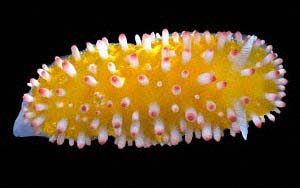
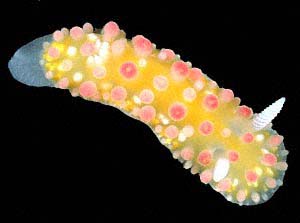
Cadlinella ornatissima
(Risbec, 1928)
Order: NUDIBRANCHIA
Suborder: DORIDINA
Family: Chromodorididae
DISTRIBUTION
Tropical Indo-West Pacific
PHOTO
UPPER: Adult animal, 34mm long alive, Heron Is, Queensland, December 1981.
LOWER: Juvenile, Solitary Islands, Coffs Harbour region, northern New South Wales. March 1988.
PHOTOS: Bill Rudman.
This species of chromodorid is easily recognised by the pink-tipped tubercules on its dorsum. It has a characteristic pattern of single-celled, flask-shaped and compound mantle glands. The large compound glands around the mantle edge can be seen around the mantle edge in the lower photo.
Reference:
• Rudman, W.B. (1984) The Chromodorididae (Opisthobranchia: Mollusca) of the Indo-West Pacific: a review of the genera. Zoological Journal of the Linnean Society, 81: 115-273.
Rudman, W.B., 1998 (December 8) Cadlinella ornatissima (Risbec, 1928). [In] Sea Slug Forum. Australian Museum, Sydney. Available from http://www.seaslugforum.net/find/cadlorna
Related messages
Cadlinella ornatissima feeding
April 1, 2010
From: Toh Chay Hoon

Dear Dr Bill,
Here are photos of Cadlinella ornatissima feeding on a sponge for your record.
Locality: Pulau Hantu, 10m, Singapore, South China Seas, 28 March 2010, Silty substrates. Length: 20mm. Photographer: Toh Chay Hoon.
Toh Chay Hoon
sonnenflower@gmail.com
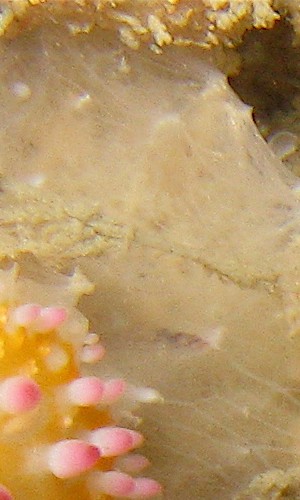

Dear Chay Hoon,
Thanks very much for this photo. With its position as a 'basal' chromodorid it would be good to have a clear idea of what this species feeds on as we now know that food specificity in the family is closely linked to their evolutionary relationships. Our evidence on the food choice of Cadlinella is not that good for this species, so any additional records are very welcome. The sponge in your photo looks like a species of Darwinella forming a very thin layer over the substrate, but I will need to have that confirmed by a sponge expert
Best wishes,
Bill Rudman
Re: Cadlinella ornatissima - egg ribbon
August 17, 2009
From: Brian Mayes

Concerning message #3439:
Dear Bill,
Here's a photo of Cadlinella ornatissima in the centre of an egg mat and presumably laying eggs. To me it looks like the spiral is started on the outside and worked to the centre.
Locality: Dive site "Koala", 17 metres, Anilao, Philippines, Philippine Sea, 3 February 2009, Reef. Length: 30 mm. Photographer: Brian Mayes.
Best Regards
Brian Mayes
brian.r.mayes@gmail.com
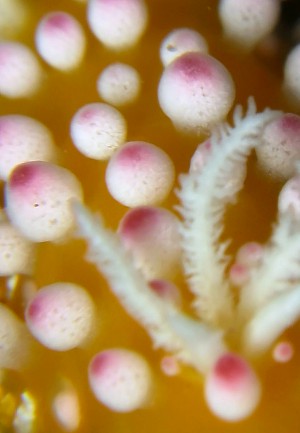
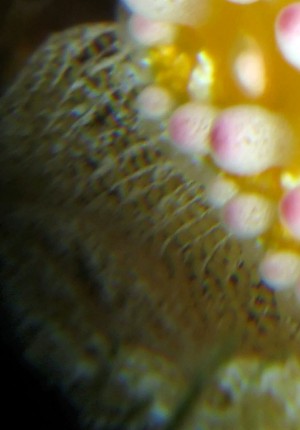

Dear Brian,
Thanks for these interesting photos. This one of the species which lays a flat egg ribbon, but looking at your photos it seems to have a 'fibrous' skeleton holding it all together. If anyone has any photos which could shed light on this they would be very welcome.
Best wishes,
Bill Rudman
Re: Cadlinella subornatissima from Kwajalein Atoll
November 12, 2008
From: Scott Johnson

Concerning message #22007:
Hi Bill,
Thanks for the comments on Cadlinella subornatissima. I'm sure that gray material in the rock crevices is sponge, but I'm afraid I cannot say for sure if the nudibranch was eating it. The particular photo of the animal strongly adhered to the rock with those patches of gray sponge around was indeed shot exactly where the animal was found. After a few minutes exposed to sunlight and camera lights, it got up and moved around. But I also cannot say if this sponge is what I thought was Halisarca metabola, the species I reported as the prey of Cadlinella ornatissima. My notes say only that a specimen was found eating that sponge, but do not say how I made that identification (and alas, my aging memory fails me on that point). I am not very knowledgeable about sponges and most of my id's from Enewetak came from comparisons with identified specimens in the collections of the Mid-Pacific Research Lab. I found Cadlinella ornatissima on a variety of substrates, but almost never could I clearly tell if they were feeding. Attached is one shot of that species that shows it near, but not on, a bit of gray sponge similar to that in the photo of C. subornatissima. It is just one more thing to watch for.
Locality: Kwajalein Atoll, 6 m, Marshall Islands, Pacific, February 1991, Under rock. Length: 15 mm [e047_09a]. Photographer: Scott Johnson.
Scott Johnson
uwkwaj@yahoo.com
Johnson, S., 2008 (Nov 12) Re: Cadlinella subornatissima from Kwajalein Atoll. [Message in] Sea Slug Forum. Australian Museum, Sydney. Available from http://www.seaslugforum.net/find/22032m2Thanks Scott,
Cadlinella is proving a difficult genus to get any solid information on its food choice. Apart from just wanting to now something about its biology, its apparent basal position in the evolution of the chromodorids means that its food choices could help to better understand how other chromodorids began to become more specialised in their food choice. We know that in the Actinocyclidae [Actinocyclus, Hallaxa] - which is the possible sister group to the chromodorids - that species feed on the sponge Halisarca, and we know that species of Cadlina feed on Halisarca and darwinellid sponges. As many species of Chromodoris feed exclusively on darwinellids this provides us with a nice link between the Chromodorididae and the Actinocyclidae. So it would be nice to have better evidence for the food of Cadlinella.
Hopefully conversations like this will jog someone's memory of a photo they have or like you, cause them to add it to their 'to do' list. I don't expect miracles, but I am more than happy with a nice surprise every now and then.
Best wishes,
Bill Rudman
Cadlinella ornatissima from sthrn Queensland
November 7, 2008
From: Gary Cobb


Hi Bill and everyone!
Please find 3 photos of different animals of Cadlinella ornatissima. Allthough not too common here, it is still found quite often, including today.
Locality: Mooloolaba, Sunshine Coast, 16 m, Queensland, Australia, Pacific Ocean, 12 October 08, Subtidal. Length: 20 mm. Photographer: Gary Cobb.
Cheers
Gary
gary@nudibranch.com.au
Cobb, G.C., 2008 (Nov 7) Cadlinella ornatissima from sthrn Queensland. [Message in] Sea Slug Forum. Australian Museum, Sydney. Available from http://www.seaslugforum.net/find/21966
Thanks Gary,
I don't suppose I need to say it, but it would be great to find this species feeding. In Scott Johnson's message today [#22007] on Cadlinella subornatissima I discuss the mantle glands in both species. Your photo alongside shows the arrangemnt in C. ornatissima very well so I have included a closer view labelling the three gland types. In a band right at the mantle edge are scattered small single glands [1]. Inside them there are aggregations of slightly larger single glands [2]; and further in are a row of very large compound glands [3] which can form a raised tubercle on the dorsal side but seem to open ventrally.
Best wishes,
Bill Rudman
Cadlinella ornatissima from the Red Sea
September 8, 2007
From: Shahar Patury
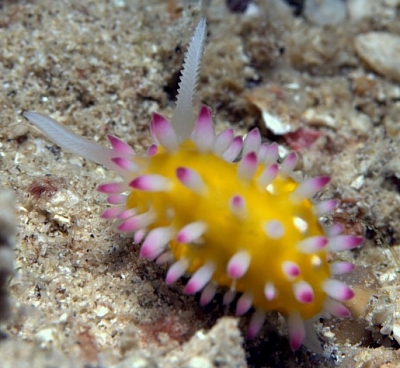
Concerning message #3326:
Hi Bill,
Matan Ninio has asked me to sent you the following pictures due to the fact he believes that this will be the first time of that slug been documented in the Red Sea (Eilat)
I will try to give as much details as I can remember
Locality: North Reservation, Eilat , ~30 metres, Israel, Red Sea, 20 July 2007, North to the Yatush, about 50 metres. Length: ~15mm. Photographer: Shahar Patury.
Thanks
Shahar Patury
shaharp@ti.com

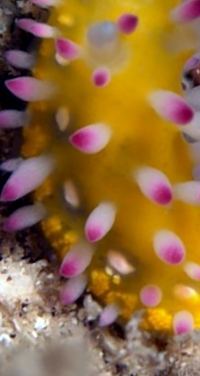
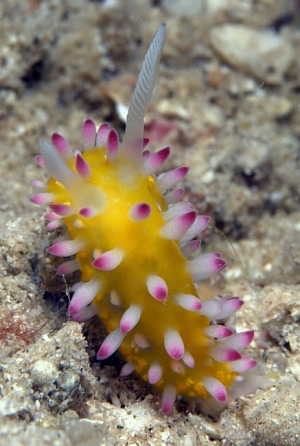
Dear Shahar,
Thanks for these great photos. I certainly don't know of a Red Sea record, so this is a useful addition to its known distribution. Your photos also show the unique arrangement of mantle glands found in Cadlinella. Mantle glands [sometimes called mantle dermal formations] are storage places for anti-feedant molecules which the slugs ingest from their food sponges. In your photos you can see a row of large white glands running in a line around the mantle some distance in from the mantle edge. Outside them are clusters of smaller whitish spheres. Usually there is a row of large clusters of these spheres and then right at the mantle edge a row of small clusters or single spheres. It would be interesting to know if these two types of glands store different secondary metabolites from their sponge food.
Most chromodorids have only one gland type, but species of the more 'primitive' genera, Cadlina and Cadlinella, can have two different types.
Best wishes,
Bill Rudman
Re: Mating Cadlinella ornatissima from nthn Marianas
June 12, 2007
From: Yuji Fujie

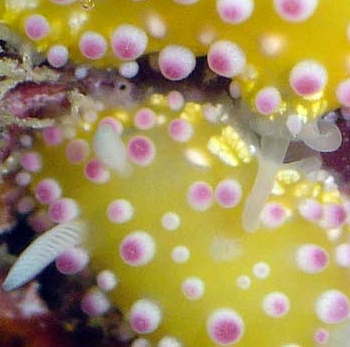
Concerning message #19943:
Dear Dr. Bill,
I have found Cadlinella ornatissima again and took some more photos. Is the whitish structure from the upper animal maybe the vas deferens?
Would you tell me the actual name, please ?
Locality: Wing Beach, 6 m, Saipan, Northern Mariana Islands, Pacific Ocean, 28 May 2007, on the wall at shallow point. Length: 15 mm and 20 mm. Photographer: Yuji Fujie.
Best regards,
Yuji
dswith@isletwind.com
Yuji Fujie, 2007 (Jun 12) Re: Mating Cadlinella ornatissima from nthn Marianas. [Message in] Sea Slug Forum. Australian Museum, Sydney. Available from http://www.seaslugforum.net/find/19981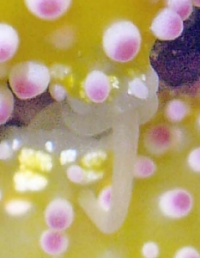
Dear Yuji,
The structure you are asking about is the penis of the upper animal. The vas deferens is the muscular internal duct through which sperm is moved from the 'male' part of the reproductive system of one partner to the 'female' part of the other partner. The penis is the 'papilla' or elongate structure which usually extends for the 'male' partner and inserts itself into the 'female' partner so that the sperm is transferred internally. If you look carefully in your second photo you can see a thin whitish duct running down the centre of the penis. This is the vas deferens.
You are probably wondering why the penis seems to be inserted into the yellow back of the lower slug, instead of into the female genital opening on the side of the body. I guess these animals don't always get it right. With hermaphrodite slugs both partners need to insert their penises simultaneously - or nearly simultaneously - and sometimes, as in this case, one partner gets it wrong.
Best wishes,
Bill Rudman
Mating Cadlinella ornatissima from nthn Mariana Islands
June 1, 2007
From: Yuji Fujie

Dear Dr. Bill,
Here we have some photos of Cadlinella ornatissima mating in Saipan.
Locality: Grotto, 12m, Saipan, Northern Mariana Islands, Pacific Ocean, 21 May 2007, on the dead coral with hians. Length: 10mm. Photographer: Yuji Fujie.
Best regards,
Yuji
dswith@isletwind.com
Yuji Fujie, 2007 (Jun 1) Mating Cadlinella ornatissima from nthn Mariana Islands. [Message in] Sea Slug Forum. Australian Museum, Sydney. Available from http://www.seaslugforum.net/find/19943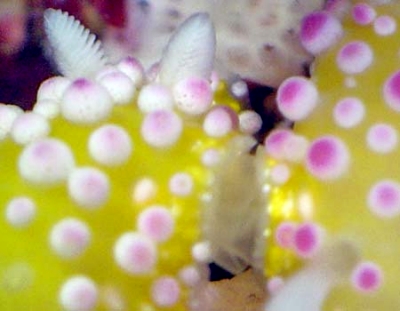
Thanks Yuji,
Best wishes,
Bill Rudman
Cadlinella ornatissima from Thailand
January 24, 2007
From: Danny Van Belle
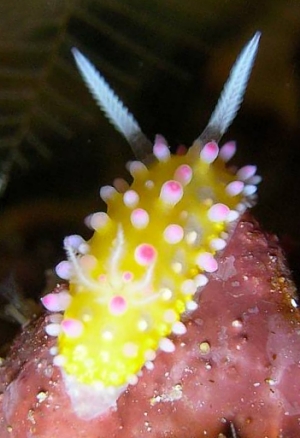
Dear Bill,
Cadlinella ornatissima from Koh Ha in Thailand.
Locality: Koh Ha , 10 m, Thailand, Indian ocean, 04 march 2006, On the rocks of reefwall. Length: 2 cm. Photographer: Danny Van Belle.
Danny Van Belle
danny.van.belle@skynet.be
Van Belle, D., 2007 (Jan 24) Cadlinella ornatissima from Thailand. [Message in] Sea Slug Forum. Australian Museum, Sydney. Available from http://www.seaslugforum.net/find/19281Thanks Danny,
Bill Rudman
Cadlinella ornatissima from Reunion Island
September 6, 2006
From: Sandrine Flodrops

Dear Bill,
Here is an other nudibranch from Reunion Island. The size is about 10-12 mm and I believe it is a juvenile Cadlinella ornatissima. I note that you have Cadlinella from South Africa and I add Reunion Island to the list.
Locality: Saint-Leu (Dive site: Banc Doré), 12 metres, Reunion Island, Indian Ocean, 10 May 2006. Length: 10-12 mm. Photographer: Sandrine Flodrops.
Regards.
Sandrine
hugues.flodrops@wanadoo.fr
Baumann-Flodrops, S., 2006 (Sep 6) Cadlinella ornatissima from Reunion Island. [Message in] Sea Slug Forum. Australian Museum, Sydney. Available from http://www.seaslugforum.net/find/17731Dear Sandrine,
Thanks for the record. This species has a wide Indo-West Pacific distribution. In fact the first time I ever saw it alive was in Tanzania, and at that time it was only known for Japan and New Caledonia. At that stage its distribution was more a distribution of nudibranch workers than a true reflection of the nudibranchs geographic range.
Best wishes,
Bill Rudman
Cadlinella ornatissima from Fiji
July 23, 2003
From: Leanne & David Atkinson
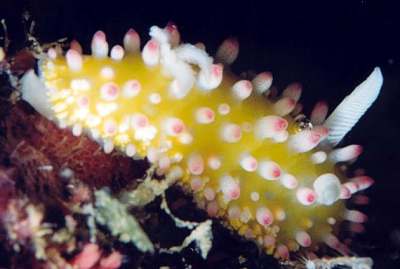
Dear Bill,
After reading Alice Lee's message re Cadlinella ornatissima we remembered taking this shot of one in Fiji earlier this year. You didn't have one from Fiji on the site and we thought you might like to add this shot. It was taken on the roof of an overhang, hence a tiny air bubble on the Cadlinella from my exhaust.
Location: Tavarua Wall, Outer Barrier Reef, Mamamanuca Islands, South West Fiji.
Depth: 18 metres
Water Temperature: 29 degrees celcius
Date: 14.04.2003 Time: 10:00am
Size of specimen: 5mm approx.
Regards,
Leanne & David Atkinson
atk@hunterlink.net.au
Atkinson, L. & D., 2003 (Jul 23) Cadlinella ornatissima from Fiji. [Message in] Sea Slug Forum. Australian Museum, Sydney. Available from http://www.seaslugforum.net/find/10447Thanks Leanne & David,
Bill Rudman
Cadlinella ornatissima from Batam, Indonesia
July 14, 2003
From: Alice Lee
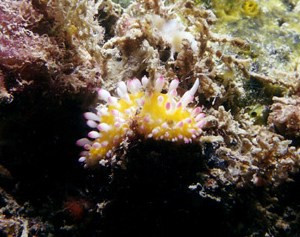
Hi, Bill,
Can you please help to identify this nudi.
Found in Batam, Indonesia.
Depth: <10m
Size: 5cm
Thanks.
Alice
alee@dlink.com.sg
Lee, A., 2003 (Jul 14) Cadlinella ornatissima from Batam, Indonesia. [Message in] Sea Slug Forum. Australian Museum, Sydney. Available from http://www.seaslugforum.net/find/10224Dear Alice,
This is Cadlinella ornatissima.
Best wishes,
Bill Rudman
Cadlinella ornatissima from Myanmar
March 26, 2003
From: Mary Jane Adams

Hi Bill,
Here is another nudibranch from Myanmar. I believe it is Cadlinella ornatissima. I found it at 23 meters on a flat area between the sea mounts of Three Islets in the Mergui Archipelago, Andaman Sea, Feb. 27, 2003. It was 15mm long.
Best regards,
Mary Jane
divepng@yahoo.com
Adams, M.J., 2003 (Mar 26) Cadlinella ornatissima from Myanmar. [Message in] Sea Slug Forum. Australian Museum, Sydney. Available from http://www.seaslugforum.net/find/9406Thanks Mary Jane,
Bill Rudman
Cadlinella ornatissima from Taiwan
October 9, 2002
From: Connie
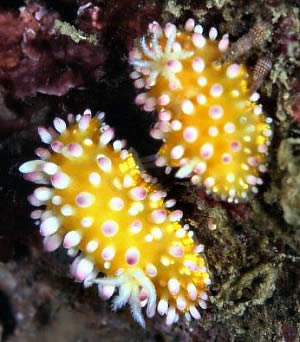
Hello Bill,
My friend and I found these beautiful nudibranchs on a shore dive. Would you be able to help us to identify these animals?
Locality: The Northeast coast, Taiwan
Depth: 8-10m
Date: August 3, 2002
Best Regards
Connie
connie.chen8d@msa.com.tw
Connie, 2002 (Oct 9) Cadlinella ornatissima from Taiwan. [Message in] Sea Slug Forum. Australian Museum, Sydney. Available from http://www.seaslugforum.net/find/7732Dear Connie,
This is Cadlinella ornatissima, which is found throughout the Indo-West Pacific. It is indeed a beautiful species.
Best wishes,
Bill Rudman
Cadlinella ornatissima from Malaysia
July 17, 2002
From: Richard Houghton
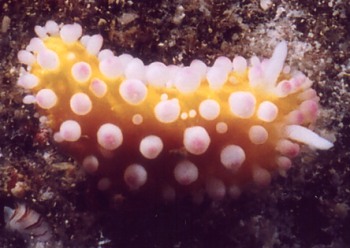
Bill,
Here is another nudibranch, perhaps phyllidiid? found off Pulau Aur, Malaysia in May 2002.
Happy diving,
Rich
richard_houghton@hotmail.com
Houghton, R., 2002 (Jul 17) Cadlinella ornatissima from Malaysia. [Message in] Sea Slug Forum. Australian Museum, Sydney. Available from http://www.seaslugforum.net/find/7544Dear Richard,
Althought looks like a pustulose phyllidiid it is Cadlinella ornatissima a rather unusual chromodorid, a famiy which contains the colourful, and mainly smooth, species of the general Chromodoris, Glossodoris and Hypselodoris.
Best wishes,
Bill Rudman
Cadlinella ornatissima from Hong Kong
January 28, 2002
From: Bill Rudman & Brian Darvell

Here is some information and photos on Cadlinella ornatissima from Brian Darvell's Hong Kong collections.
This uniquely shaped chromodorid is characterized by a yellow mantle covered in elongate white pink-tipped tubercles. The anatomy and taxonomy were fully reviewed recently (Rudman 1984). Specimens are known to reach 35 mm in length. It is reported to feed on the sponge Halisarca metabola de Laubenfels, 1954 (Johnson and Boucher 1983).
PHOTO:
AM C145659, 3 February 1985, Site 9.160, Yat Chap Mo, Rocky Harbour, 5 m. Depth range: 5-12 m, Hong Kong. Photo: Brian Darvell.
Hong Kong Collection Records:
AM C138146, 27 February 1983, Site 1.4, Ngo Mei Wan, Crescent Is., Mirs Bay, 7 m. AM C139056, 24 April 1983, Site 6.62, Flat Reef, Tolo Channel, 7-12 m. AM C142177, 21 April 1984, Site 10. 103, Pak Ma Tsui (Bay), Port Shelter, 9 m. AM C145659, 3 February 1985, Site 9.160, Yat Chap Mo, Rocky Harbour, 5 m. Depth range: 5-12 m.
Reference:
• Rudman, W.B. & Darvell, B.W. (1990) Opisthobranch molluscs of Hong Kong. Part 1. Goniodorididae, Onchidorididae, Triophidae, Gymnodorididae, Chromodorididae, (Nudibranchia). Asian Marine Biology, 7: 31-79
Best wishes,
Bill Rudman & Brian Darvell
Tonga Records: Cadlinella ornatissima
May 29, 2001
From: Don Barclay

Hello Bill,
You already have lots of pics of this one on the Forum, but Cadlinella ornatissima it's still one of the prettiest nudibranchs I've seen. This bright little fellow was found under a slab in 20 meters of water across the channel from the Tongan Beach Resort, Utungake Island, Vava'u, Tonga , on the afternoon of 16 February 2001. Size about 15mm.
Cheers,
Don
n5ols@samoatelco.com
Barclay, D., 2001 (May 29) Tonga Records: Cadlinella ornatissima. [Message in] Sea Slug Forum. Australian Museum, Sydney. Available from http://www.seaslugforum.net/find/4406Thanks Don,
Bill Rudman
Cadlinella ornatissima from New Zealand
April 5, 2001
From: Gareth Jones
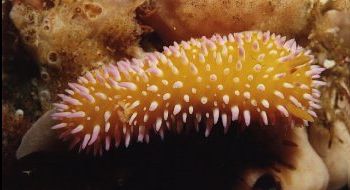
Hi Bill,
I am sending you photos of a couple of nudibranchs I've seen recently. I think this one is Cadlinella ornatissima. I photographed it at the Poor Knights Islands (northeastern new Zealand) during March, 2001 at about 25m. Water temp 21C.
The other one, which I am sending separately is I think Plocamopherus imperialis
Cheers.
Gareth Jones
rees@divenz.co.nz
Jones, G., 2001 (Apr 5) Cadlinella ornatissima from New Zealand. [Message in] Sea Slug Forum. Australian Museum, Sydney. Available from http://www.seaslugforum.net/find/4119Dear Gareth,
These are two interesting finds. Especially Cadlinella ornatissima which is, to my knowledge, the first record of this species from New Zealand.
Each year it seems that more species of molluscs, normally found in southeastern Australia or tropical waters, are being recorded from northern New Zealand. This probably reflects a greater population of interested divers than a change in global climatic conditions. The presence of these species in New Zealand is probably like their presence in New South Wales - chance settlement of larvae when conditions are good, rather than evidence of stable, self-sustaining populations.
Building up information on the presence of shelled molluscs has been relatively easy, because the shell can be collected, and later examined and identified by experts. It has been more difficult to build up records of which nudibranchs occur in northern New Zealand, because collecting and preserving specimens for future study is a time-consuming task which most amateurs are understandably reluctant to get involved in. Unless photographs are taken, there has been no easy way to confirm possible sightings. So photos like yours are invaluable. Thanks again, and any other photos are very welcome
best wishes,
Bill Rudman
Colour variation in Cadlinella ornatissima
December 26, 2000
From: Scott Johnson
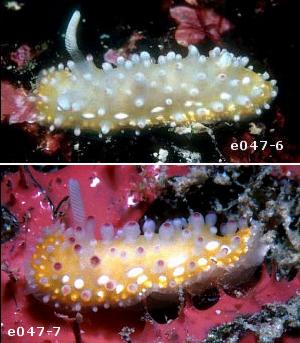
Hi Bill,
Attached are some color variations of Cadlinella ornatissima found here in the Marshall Islands. Specimens from Enewetak and Kwajalein range from pale, with very light yellow dorsal color and only a trace of pink on the tubercle tips, to the more characteristic dark yellow with darker pink tips. Some, such as E047-7, can have more translucent tubercles or distinct
white spots on the yellow dorsum. The most interesting one was the single specimen I collected on my second trip to Bikini Atoll in 1982. This one, e047bik, was 11mm in length and had an interesting network of broken orangeyellow lines on the dorsum and no trace of pink on the tubercles.
In a separate message an individual (e047-3), with another colour variation, is next to its egg mass.
Scott
johnson@kmr.ll.mit.edu


Thanks Scott,
It certainly is quite variable in colour
Bill Rudman.
Cadlinella ornatissima - egg ribbon
December 26, 2000
From: Scott Johnson
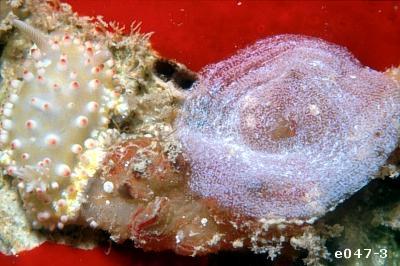
Hi Bill,
To accompany my message on color variations in Cadlinella ornatissima in
the Marshall Islands, here is a photo I took of an individual next to its egg mass, which is deposited flat against the substrate similar to those of some species of Chromodoris.
Scott
johnson@kmr.ll.mit.edu
Johnson, S., 2000 (Dec 26) Cadlinella ornatissima - egg ribbon. [Message in] Sea Slug Forum. Australian Museum, Sydney. Available from http://www.seaslugforum.net/find/3439Dear Scott,
Thanks for this interesting photo. I wonder why some species lay their egg ribbon flat on the substrate while most lay it with only one edge attached. It certainly doesn't seem to be unique to any genus or phylogenetically discrete group. If anyone has photos of species laying this type of egg mass it could be an interesting addition to our knowledge of these animals.
Bill Rudman.
Cadlinella ornatissima from South Africa
December 12, 2000
From: Valda Fraser

Dear Bill
I note that you have contributions of Cadlinella ornatissima from Australia and Thailand. Now we can add South Africa to the list.
Locality: Sodwana, north coast KwaZulu-Natal, SOUTH AFRICA, 30m
Date: Nov 2000
Size: 15mm
Regards
Valda Fraser
valdafraser@mweb.co.za
Fraser, V., 2000 (Dec 12) Cadlinella ornatissima from South Africa. [Message in] Sea Slug Forum. Australian Museum, Sydney. Available from http://www.seaslugforum.net/find/3326Thanks Valda,
I also reported it some years ago from Tanzania, in east Africa, so it is truly an Indo-West Pacific species.
Best wishes,
Bill Rudman.
Cadlinella from Thailand
June 29, 1999
From: Erwin Koehler

Bill,
Attached a photo by Georg Heinze: Thailand, Similan Is., March 1999, size about 2cm. I think it looks like Cadlinella ornatissima (Risbec, 1928), but I don't know if there are other similar looking species.
Erwin
Medslugs.Koehler@t-online.de
Dear Erwin,
This is Cadlinella ornatissima. In the other described species, the tubercules have become tapering papillae.
Bill Rudman.
Re: Cadlinella ornatissima
December 22, 1998
From: Stephanie A. Clark
Dear Bill
I was browsing through the recent messages and I was a note about Cadlinella being found in Sydney. Well this prompted my memory and I pulled out my diary as I recall collecting this species down at Bass Point.
Sure enough I found my record I found it on the 15 Jan 1989 at a dive spot known as the Gutter, at Bass Point, NSW (Approximately 100km south of Sydney). It was at 14m and I think it was on a sponge but that is testing memory just a little to much.
So I hope you and others who browse this site will continue to look out for this great looking species.
Regards
Stephanie
inverte@internet-australia.com
Clark, S.A., 1998 (Dec 22) Re: Cadlinella ornatissima. [Message in] Sea Slug Forum. Australian Museum, Sydney. Available from http://www.seaslugforum.net/find/415Thanks Stephanie,
Any records gratefully received. It is interesting how it is possible to find tropical species as far south as Green Cape on the southern border of New South Wales. It seems the geography of the coast makes this on of the few examples where political borders and biological boundaries coincide.
Bill Rudman.
Cadlinella from Sydney
December 8, 1998
From: Akos Lumnitzer

Dear Bill,
I saw this slug at Shark Point, Clovelly at the entrance of Botany Bay, Sydney. I first saw it in late October 1998, in 19 meters. I sighted it on two dives and then it disappeared.
Akos Lumnitzer.
AKOS72@hotmail.com
Lumnitzer, A., 1998 (Dec 8) Cadlinella from Sydney. [Message in] Sea Slug Forum. Australian Museum, Sydney. Available from http://www.seaslugforum.net/find/366Dear Akos,
This is another tropical species which is rarely seen in New South Wales. As with your record of Chromodoris geometrica I don't recall it being recorded from as far south as Sydney, before. ... Bill Rudman.
